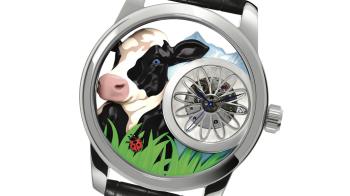On view during Geneva’s watch week, spearheaded by Watches and Wonders, are many complex, serious, sometimes very serious watches. Watches for collectors whose wealth often isn’t limited to their knowledge. Yet beyond the walls of Palexpo, another world exists; that of wildly creative independents whose ideas frequently go against the grain. Claude Meylan is one.
Cowabunga!
The brand specialises in skeleton watches. Not necessarily works of great art governed by the centuries-old canons of haute horlogerie, but a more affordable, more whimsical and in many cases more creative skeleton – as proven by the model unveiled this week in Geneva.
The dial leads the eye through different planes. We see a ladybird, a grassy meadow and, stealing the show, a magnificent cow looking right at us. You “herd”! A beautiful Swiss cow. (Bovines are clearly popular with indie brands – a past collection from Michel Jordi featured bell-bedecked cows and edelweiss.)

Beneath its playful exterior, it reminds us that the very first watchmakers were of peasant stock. Deep in the Vallée de Joux, they spent long winter evenings hand-fashioning tiny components, which they then delivered to the établisseur for assembly into pocket watches and, later, wristwatches.
Notwithstanding its whimsical nature, this new model is executed with Claude Meylan’s habitual proficiency, with the Swiss-Made movement visible at 3 o’clock. The tips of the two snow-white hands are a hollowed apple shape à la Breguet, and this gives what is a delightful watch its dual personality: amusing on the outside, steeped in history on the inside. Which side of its character you see is entirely up to you. Even without complex mechanical convolutions, this is probably one of the week’s favourite conversation pieces, and no beef about it.

Noblesse oblige
To say that Claude Meylan switches registers with its new women’s watch would be an understatement. The brand leaves Switzerland and its Alpine meadows behind to reappear in eighteenth-century Versailles. Why choose Versailles as the inspiration for this delicately skeletonised model? For a particular shade of grey, named for Marie-Antoinette, the ill-fated wife of Louis XVI.
The name of this muted pastel grey is anachronistic, “Marie-Antoinette grey” never having existed during the queen’s short lifetime. It originated with a white pigment whose high lead content caused it to gradually turn a pale grey. Another of the particularities of lead is that it was also used, in France during the Ancien Régime and in Elizabethan England, as a (poisonous) skin lightener. Lead is, incidentally, the first of the seven metals of alchemy, whose symbol is also used to represent the planet Saturn, saturnism being another word for lead poisoning.
Not that there is any lead here; only the pastel grey of the bezel inscribed with Roman numerals. The Breguet hands have particular relevance, as both Marie-Antoinette and Louis XVI were patrons of the great man. As for the movement, it adopts a delicate blush pink. In a similar vein, the strap replaces traditional leather with grey satin, more in keeping with the watch’s aristocratic leanings. The movement, an ETA 2892, slips into a steel case with a diminutive 35mm diameter. Power reserve is a princely 42 hours.





